Exploring the Polytunnel Market: Insights and Analysis
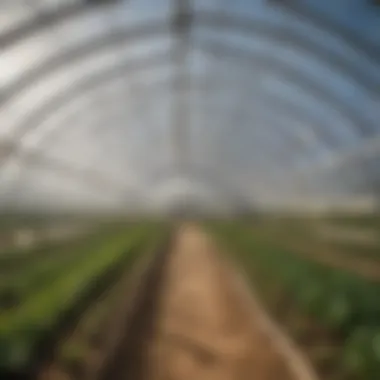
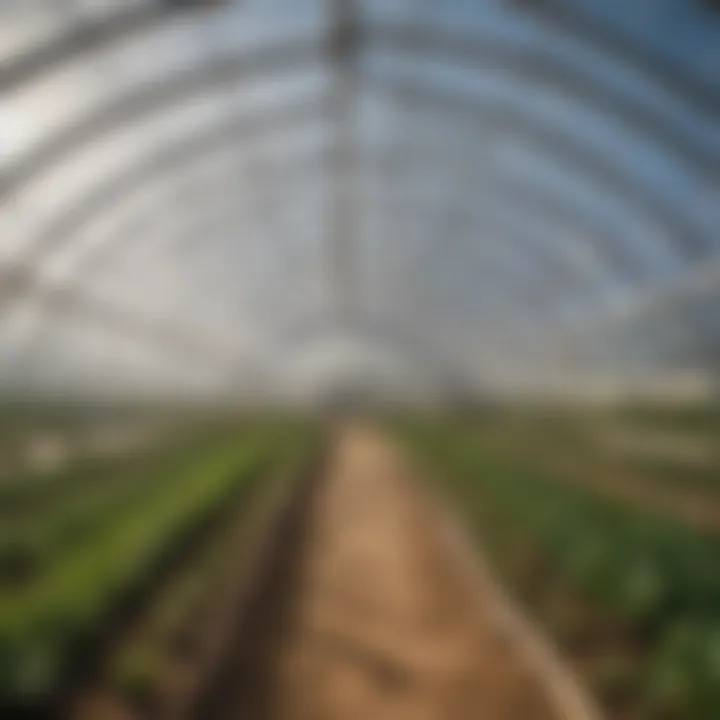
Overview of the Topic
Definition and Importance
Polytunnels, also known as hoop houses, are structures specifically designed for agricultural use. They are typically made from a framework of metal or plastic, with a covering of transparent or translucent plastic sheeting. This design allows sunlight to penetrate while providing protection from harsh weather conditions. Polytunnels play a crucial role in extending the growing season for various crops, enabling farmers to cultivate produce that might not thrive in an unprotected environment. Their importance in modern agriculture cannot be understated, as they contribute significantly to increased yield and efficiency in farming practices.
Current Trends
The polytunnel market has experienced a number of trends in recent years. One notable trend is the increasing adoption of sustainable farming practices. Many farmers are becoming more conscious of their environmental impact and are seeking to minimize it. Polytunnels enable this by allowing for controlled environmental conditions, which can lead to reduced pesticide use and optimized resource management. Furthermore, technological advancements are influencing the market, with features such as automated ventilation systems and climate control sensors becoming more prevalent. These innovations help farmers manage their crops better and raise productivity.
Key Techniques and Practices
Step-by-Step Guide
- Choosing the Right Type of Polytunnel: There are various designs available, including quonset, gothic, and tunnel styles. Each has unique features that make them suitable for different applications and crop types.
- Site Selection: The location of the polytunnel should be well-drained and receive ample sunlight throughout the day.
- Installation: Proper installation is key. Make sure to follow the manufacturer’s instructions closely. Secure the frame, stretch the covering taut, and ensure good ventilation.
- Crop Selection: Choose crops that are conducive to a polytunnel environment. Leafy greens, tomatoes, and peppers are popular choices.
- Maintenance: Regularly inspect the structure and covering for wear and tear. Also, monitor crop health closely.
Tools and Equipment Needed
To set up and maintain a polytunnel effectively, a few essential tools and equipment are necessary:
- Shovel and hoe for initial site preparation
- Hammer and nails or screws for assembly
- Clips and fasteners for securing the cover
- Irrigation system to manage water supply
- Thermometer and hygrometer to monitor internal conditions
Challenges and Solutions
Common Obstacles
Several challenges arise when utilizing polytunnels. The most common include:
- Weather Vulnerability: Polytunnels can suffer damage from strong winds or heavy snow.
- Pest Management: While polytunnels help control some pests, they can also create favorable conditions for others.
- Cost Considerations: Initial investment can be high, depending on size and features.
Innovative Solutions
Fortunately, solutions exist for many of these challenges:
"Investing in high-quality materials can substantially minimize damage risks, and using integrated pest management strategies can help address pest issues."
- Strengthening Structures: Reinforcing the frame with additional supports can make polytunnels more resilient against severe weather.
- Residuals Management: Utilizing natural predators and organic solutions can mitigate pest problems efficiently.
- Financing Options: Many governments and organizations offer grants or low-interest loans to assist farmers in acquiring polytunnels.
By acknowledging these points, farmers can navigate the complexities associated with polytunnels more effectively and harness their full potential in enhancing agricultural productivity.
Prolusion to Polytunnels
Polytunnels represent a significant innovation in the realm of agricultural practices, offering a systematic approach to crop production. Understanding the role of polytunnels is crucial for modern farmers seeking to enhance their output and sustainability. These structures have gained popularity due to their ability to create a controlled environment, thus extending the growing season and improving plant health.
The core purpose of a polytunnel is to protect crops from unpredictable weather conditions, pests, and diseases. By utilizing these structures, farmers can optimize their yield and quality of produce. The application of polytunnels spans a variety of crops, ranging from vegetables to flowers, and even berries.
One notable aspect of introducing polytunnels in agriculture is the capacity to manipulate environmental factors such as temperature, humidity, and ventilation. This manipulation is particularly valuable in regions where climate constraints can limit agricultural productivity. When a polytunnel is utilized effectively, it can significantly minimize the risks associated with adverse weather, ensuring that crops are able to thrive under more favorable conditions.
Considerations in Polytunnel Adoption
Before investing in polytunnels, several key elements require thoughtful consideration:
- Investment Costs: Initial outlay can be significant, depending on the type and size of the structure.
- Site Selection: Choosing the right location ensures optimal sunlight exposure and reduces risks from high winds.
- Design Features: Different designs offer various benefits; selecting the right one can maximize efficiency and crop health.
In summary, comprehending the landscape of polytunnel farming is essential for both novices and seasoned farmers. With their proven advantages, polytunnels are not just a trend but a strategic asset in modern agriculture. As we delve deeper into this market analysis, we will explore various aspects such as types of polytunnels, benefits, challenges, and future trends, all of which contribute to making informed decisions.
Understanding Polytunnels
Polytunnels play a vital role in modern agriculture. This section delves into their specific purpose and significance. Understanding polytunnels is not just about knowing what they are; it involves recognizing their impact on crop production, sustainability, and efficiency in farming practices.
Definition and Purpose
A polytunnel is a structure made of a frame covered with a plastic film that creates a controlled environment for growing plants. These structures are designed to trap heat and moisture, which leads to improved growth conditions. The primary purpose of a polytunnel is to extend the growing season, enabling farmers to cultivate crops earlier in spring and later into autumn.
The advantages of polytunnels are manifold:
- Climate Control: They provide a buffer against harsh weather, including frost and excessive rainfall. This facilitates better control over variables like temperature and humidity.
- Resource Efficiency: By allowing for water conservation techniques, polytunnels reduce the need for irrigation compared to traditional open fields.
- Pest Management: Enclosed environments help in minimizing pest infestations, which is significant for organic farming techniques.
History of Polytunnels in Agriculture
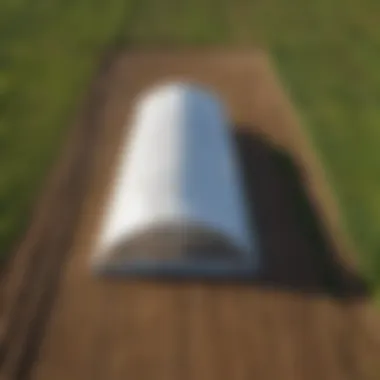
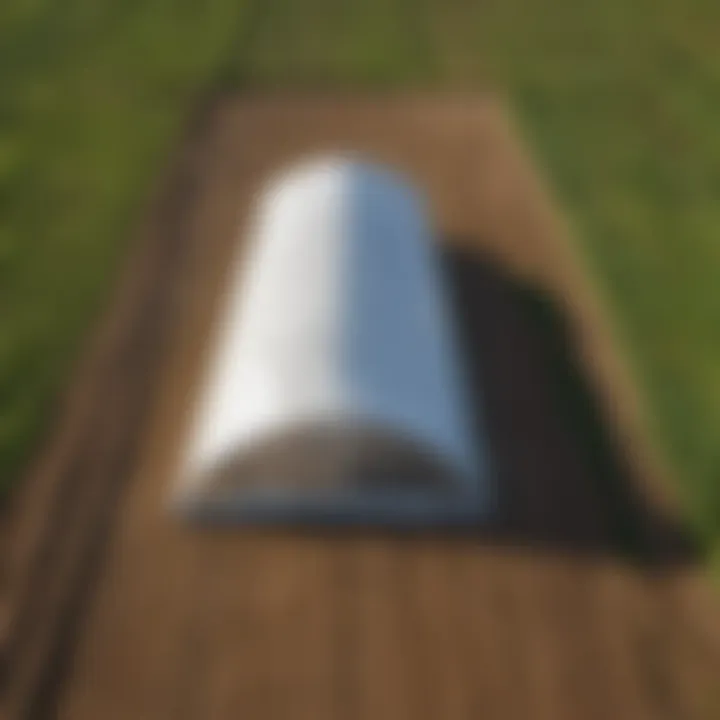
The concept of using polytunnels is not recent; they have a significant historical footprint in agriculture. The origins of this agricultural technology can be traced back to the mid-20th century. Initially developed for research purposes, polytunnels began gaining traction with farmers looking to optimize their production methods.
In the 1960s and 1970s, plastic sheeting became more accessible. This advancement allowed farmers to construct their own tunnels on a wider scale. As awareness of climate change increased, the interest in sustainable farming practices also rose. Polytunnels offered a practical solution for mitigating some adverse effects of climate variability.
Today, polytunnels are common across the globe, from small-scale hobby gardens to extensive commercial farms. They symbolize the intersection of tradition and technology, providing a method for farmers to respond to the challenges posed by weather and pest pressures.
Understanding the definition, purpose, and history of polytunnels is essential. This knowledge lays the groundwork for appreciating their role in contemporary agriculture. The next sections will further dissect the various types of polytunnels available, their benefits, and the factors to consider while selecting the right model for specific agricultural needs.
Types of Polytunnels Available for Sale
Understanding the different types of polytunnels is crucial for anyone involved with agriculture. The selection process influences not just crop yield but also cultivation strategies, cost management, and long-term sustainability. This section aims to explore the key elements that define the variety of polytunnels available in the market, reflecting on their unique benefits and considerations.
Different Designs and Structures
Polytunnels come in various designs and structures, tailored to meet different agricultural needs. The most common designs include low hoops and Gothic structures. Low hoops are generally easier to construct and more cost-effective. They work well for smaller fields or gardens, letting farmers easily manage their crops.
On the other hand, Gothic structures are more spacious and allow for better air circulation, which can enhance plant growth. Both forms have pros and cons. The choice may depend on factors such as climate, crops being grown, and available budget. Additionally, some manufacturers offer customized designs to accommodate specific farm layouts or local conditions.
Materials Used in Construction
The materials utilized in the construction of polytunnels can vary significantly, impacting their durability and performance. Typically, galvanized steel or aluminum frames are employed for the structure due to their resistence to rust and long lifespan. Plastic covers, usually polyethylene, are also employed for their transparency, which allows sunlight to penetrate, essential for photosynthesis.
It is essential to consider the quality of materials when selecting a polytunnel. Lesser materials may save costs upfront, but could lead to maintenance issues down the line. Choosing robust and UV-resistant covers, for example, ensures longer life and better protection against harsh weather.
Size Variations and Their Applications
Size is another critical factor. Polytunnels are available in various dimensions to accommodate different farming scales and crop types. Smaller tunnels, usually under 10 meters in length, can be ideal for hobbyists or small-scale farmers. They are perfect for nurturing seedlings or defending delicate plants against early frost.
Larger structures, on the other hand, often exceed 20 meters and are designed for commercial farming. These size variations enable farmers to select the appropriate tunnel for their specific agricultural practices. Larger tunnels can house extensive crop production, enabling year-round cultivation. Thus, understanding these size variations can vastly improve a farmer's productivity and profitability.
Benefits of Using Polytunnels
Polytunnels provide several significant advantages that can greatly enhance agricultural productivity. Understanding these benefits is crucial for farmers seeking to maximize their output while minimizing risks. This section explores three main benefits: extended growing seasons, enhanced crop yield and quality, and pest and disease control. Each of these elements plays a vital role in the decision-making process for adopting polytunnel farming strategies.
Extended Growing Seasons
One of the primary benefits of polytunnels is the ability to extend the growing season for various crops. By providing a controlled environment, polytunnels shield plants from adverse weather conditions and temperature fluctuations. This allows farmers to plant earlier in the spring and continue harvesting later into the fall. With polytunnels, some crops can be grown year-round in certain climates. This is particularly important for regions with short growing seasons, where farmers can maximize productivity despite environmental challenges.
The benefits include:
- Climate Regulation: Polytunnels maintain higher temperatures and humidity levels compared to open fields.
- Frost Protection: They protect young plants from frost, which can be crucial in spring and fall.
- Improved Resilience: The controlled environment helps plants withstand extreme weather events, increasing survival rates.
Be sure to consider the unique conditions of your local climate when calculating the potential advantages of extended growing seasons using polytunnels.
Enhanced Crop Yield and Quality
Polytunnels not only allow for longer growing seasons but also contribute to improved crop yield and quality. In a controlled environment, crops often experience less stress. This results in better growth rates and higher quality produce. The consistent conditions offered by polytunnels help reduce variances in growth patterns caused by unpredictable outdoor weather.
Specific factors contributing to enhanced yield and quality include:
- Optimal Light Exposure: Transparent materials used in polytunnel construction allow for adequate sunlight while blocking harmful UV rays.
- Reduced Pest Damage: Enclosed structures often lead to lower infestation rates, resulting in healthier plants.
- Improved Water Management: Watering practices can be controlled, leading to better hydration and nutrient absorption, which directly impacts yield.
Farmers who utilize polytunnels can achieve premium prices for their products due to superior quality, making this investment worthwhile.
Pest and Disease Control
Another significant benefit of polytunnels is their effectiveness in controlling pests and diseases. The physical barrier created by polytunnels helps protect plants from a variety of agricultural threats. This leads to fewer pesticide applications, resulting in a healthier ecosystem and cost savings for farmers.
Key points of importance in pest and disease control are:
- Physical Barrier: Polytunnels prevent many common insects from accessing crops, reducing pest populations and damage.
- Disease Management: The enclosed environment decreases the likelihood of disease outbreaks caused by rain or wind.
- Integrated Pest Management: Farmers can implement better strategies by monitoring pests within a controlled system, leading to targeted interventions rather than broad applications.
Implementing polytunnels can therefore support sustainable farming practices, benefiting both farmers and the environment.
"Polytunnels offer a unique solution for modern agriculture, enabling higher productivity and better quality crops while addressing environmental challenges."
In summary, the benefits of using polytunnels are substantial. They provide growers with the ability to extend growing seasons, enhance crop yield and quality, and effectively manage pest and disease risks. Each benefit contributes to a more resilient agricultural practice, aligning with the goals of many contemporary farmers.
Challenges of Polytunnel Farming
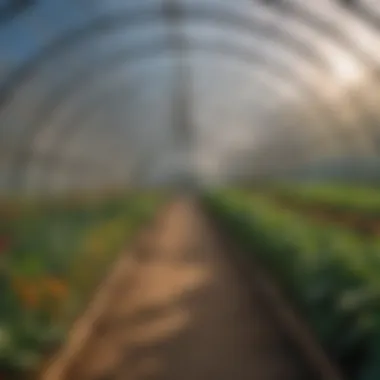
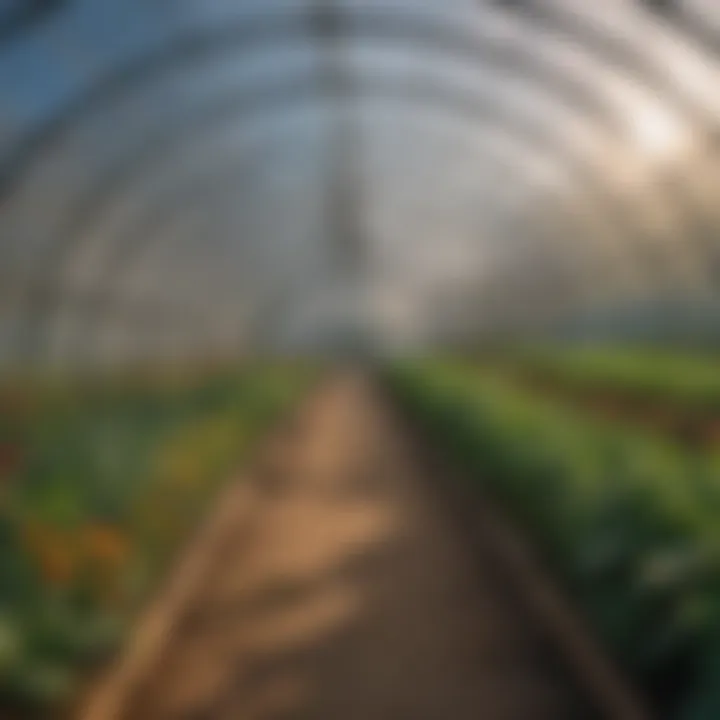
Polytunnels offer numerous advantages for modern agriculture, yet they are not without challenges. Understanding these difficulties is crucial for farmers and agricultural enthusiasts as they seek to optimize their practices. The challenges associated with polytunnel farming can influence decision-making processes, investment choices, and long-term sustainability strategies.
Identifying these challenges allows growers to prepare accordingly and mitigate risks. It emphasizes the importance of planning, foresight, and adaptability in agriculture.
Initial Investment Costs
The initial investment costs involved in setting up a polytunnel can be substantial. Farmers must consider not only the price of the structure itself but also the land preparation, installation, and additional equipment needed.
Cost factors may include:
- Polytunnel Structure: Prices vary based on size, materials, and features. Higher quality materials can lead to longer lifespan but increase upfront costs.
- Land Preparation: This may entail soil testing, amendments, and possibly drainage solutions.
- Equipment and Accessories: Items such as heating systems, irrigation setups, and fans for ventilation affect overall budgets.
A precise cost analysis is necessary. This analysis should account for potential savings from extended growing seasons and increased crop yields. Many farmers find that while the initial costs are high, the long-term benefits can result in a positive return on investment.
Maintenance Requirements
Ongoing maintenance is essential for the longevity of polytunnels. Unlike traditional greenhouses, polytunnels require specific attentiveness to ensure they remain effective. Regular checks are necessary to identify signs of wear and tear or damage from weather conditions.
Typical maintenance tasks include:
- Repairing Torn Films: Polytunnel covers can get damaged from strong winds or falling objects. Timely repairs can help avoid further issues.
- Cleaning: Keeping the structure clean allows for maximum sunlight penetration, which is essential for plant growth.
- Monitoring Temperature and Humidity: Adjustments may be needed to maintain optimal growing conditions, requiring regular checks and possibly additional equipment.
Effective maintenance practices can minimize long-term costs and improve overall efficiency in crop production.
Weather Dependency and Risks
Weather is a significant factor in agricultural success. Polytunnel farming, while offering protection from some elements, does not entirely remove weather-related risks. Several elements impact farmers:
- Temperature extremes: Polytunnels can overheat during hot days. Without proper ventilation, plants may suffer from heat stress.
- Heavy snow or wind: These conditions can threaten the integrity of polytunnels. Regular monitoring is required to ensure structures remain secure.
- Humidity levels: Overly humid conditions inside a polytunnel can lead to mold and disease. Monitoring systems and airflow management are crucial to prevent this.
Navigating weather dependency is vital for successful polytunnel farming. Practical responses to weather conditions can prevent damage to both crops and infrastructure. Effective planning and preparation enable farmers to harness the benefits of polytunnels while minimizing associated risks.
Selecting the Right Polytunnel
Selecting the right polytunnel is a critical aspect of agricultural planning. This decision influences not only initial investment costs but also the long-term productivity and sustainability of farming operations. Farmers and enthusiasts must consider various factors to ensure that the polytunnel they choose meets their specific needs. A well-chosen polytunnel can provide significant advantages, such as enhanced crop yield, protection from adverse weather, and extended growing seasons. Thus, this section evaluates key elements related to selection, focusing on understanding agricultural needs, available options, and achieving value for investment.
Assessing Your Agricultural Needs
Before diving into available styles and specifications, it is essential to assess your agricultural needs thoroughly. This step involves evaluating the types of crops you intend to grow. Different polytunnels are suitable for different plants. For example, tomatoes thrive in warm conditions provided by a well-insulated structure, while leafy greens may require less heat.
Consider the local climate and seasonal variations as well, as these will influence your choice. If you are in an area with extreme temperatures, a more robust polytunnel with better ventilation may be needed. Additionally, assess the size of the polytunnel based on the scale of your farming operation. A larger structure may be necessary for commercial ventures, whereas a smaller one might suffice for hobby farming. It's important to reflect on your growth plans for the future; short-term needs should not compromise long-term goals.
Evaluating Available Options
With a clear understanding of your agricultural needs, the next step is evaluating the available polytunnel options. The market offers a variety of designs, materials, and sizes to cater to diverse requirements. Key factors to consider include:
- Structure Type: Some polytunnels have a hoop design, while others may come with more rigid frameworks. Choose the structure that offers the best support for your intended crop types.
- Material Quality: The use of greenhouse-grade plastic can increase longevity and yield. Look for UV-resistant and heat-retaining materials that can withstand local weather conditions.
- Ventilation Systems: Proper airflow is crucial in preventing plant diseases. Some polytunnels come equipped with manual or automatic ventilation to control humidity and temperature.
It's advisable to read product reviews and consider case studies from other farmers who have used specific types. This real-world feedback can provide valuable insights that go beyond specifications.
Getting the Best Value for Investment
To ensure a successful investment in a polytunnel, it is essential to gauge not just the initial purchase price but also the overall long-term value. Consider these aspects:
- Durability and Maintenance: A cheaper option may seem appealing at first but could lead to higher repair or replacement costs in the future. Consider the warranty and the manufacturer's reputation to assess durability.
- Operational Costs: Factor in costs associated with heating, cooling, and irrigation systems that may be necessary for optimal production within the polytunnel.
- Resale Value: In some cases, choosing a polytunnel with good resale potential can offset initial costs if you decide to upgrade in the future.
"The long-term benefits of a well-chosen polytunnel can significantly outweigh the initial costs, especially when considering productivity gains."
Sustainable Practices in Polytunnel Use
In recent years, the shift towards sustainable agriculture has gained momentum. Sustainable practices in polytunnel use are increasingly essential for modern farming. They help minimize environmental impact while improving efficiency. Adopting these practices can enhance soil health, reduce resource consumption, and contribute to long-term agricultural viability. Key elements include the use of eco-friendly materials, water conservation techniques, and integrated pest management strategies.
Eco-Friendly Materials and Designs
The choice of materials for polytunnels significantly influences their sustainability. Many companies now offer polytunnels made from recyclable or biodegradable materials. Using such materials reduces waste and lowers the carbon footprint associated with manufacturing.
Additionally, eco-friendly designs can enhance energy efficiency. For instance, polytunnels designed with better insulation can maintain optimal temperatures with less energy input. This efficiency is crucial, especially in regions with extreme weather conditions. Investing in sustainable materials also aligns with consumers’ growing preference for locallly-sourced produce and eco-conscious farming practices.
Water Conservation Techniques
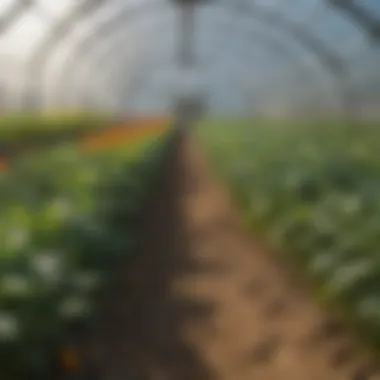
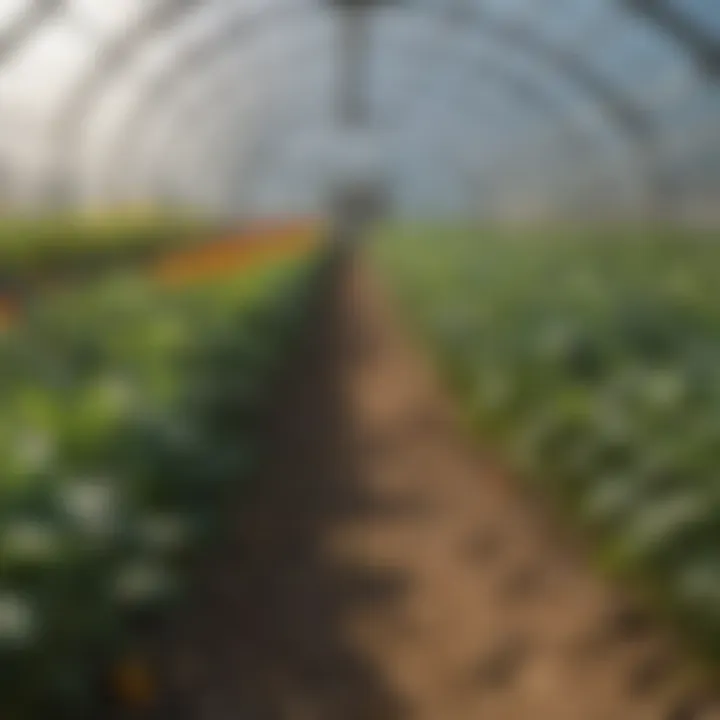
Water is a vital resource in agriculture, and its conservation in polytunnel use is critical. Techniques such as drip irrigation or rainwater harvesting can significantly reduce water wastage. Drip irrigation delivers water directly to the plant's roots. This method minimizes evaporation and runoff. Rainwater harvesting can also play an important role. By capturing and using rainwater, farmers can lessen their dependence on municipal water supplies.
Effective mulching is another way to conserve moisture in polytunnels. Mulch not only retains soil humidity but also suppresses weed growth. Implementing these water conservation strategies can lead to more sustainable farm management practices.
Integrated Pest Management in Polytunnels
Managing pests is a crucial part of sustainable agriculture. Integrated pest management (IPM) combines various strategies to control pests in a way that minimizes harm to the environment. Techniques in IPM include using natural predators, utilizing organic pesticides, and implementing physical barriers.
By monitoring pests and implementing control measures when necessary, farmers can effectively manage pest populations without resorting to harmful chemicals. This approach not only supports healthier crops but also encourages biodiversity. Since polytunnels can foster specific ecosystems, implementing IPM ensures that beneficial organisms thrive, thus providing additional pest control.
"Sustainable practices in polytunnel farming contribute to healthier ecosystems and optimal crop production while safeguarding natural resources."
Overall, the sustainable practices in polytunnel use are integral to the future of agriculture. They provide a framework that farmers can use to balance productivity with environmental stewardship. The integration of eco-friendly materials, water conservation efforts, and effective pest management techniques creates a holistic approach to farming. This will not only improve crop yields but also ensure that farming remains viable for future generations.
Economic Implications of Polytunnels
The economic implications of polytunnels play a crucial role in understanding their value in agricultural practices. Farmers need to have a clear grasp of how investing in these structures can impact their operations, both financially and strategically. This section delves into the financial aspects of polytunnels, providing insightful analysis to aid decision-making.
Cost-Benefit Analysis
A cost-benefit analysis is essential for evaluating the economic viability of polytunnels. This assessment involves comparing the initial investment against potential returns. Here are some key factors to consider:
- Initial Costs: The price of purchasing and installing a polytunnel can vary significantly based on size and materials. Common structures may range from a few hundred to several thousand dollars.
- Operational Costs: These include maintenance, labor, and utilities such as heating or irrigation. Understanding these ongoing costs is important for calculating profits.
- Potential Revenue: Increased crop yield and quality can lead to higher market prices. Polytunnels allow for extended growing seasons, which can enhance farmers' revenue streams.
- Risk Reduction: Polytunnels provide some protection against adverse weather events, potentially saving growers from loss.
"Investing in polytunnels is not just about upfront costs, but also about understanding long-term financial benefits."
The timing of the investment also matters. Seasonal crops might yield faster returns, while perennials may take longer but can lead to significant future profits. Despite the costs, many farmers find the benefits exceed the initial expenses, especially in regions with challenging climates.
Market Trends and Demands
Understanding current market trends and demands is vital for farmers considering polytunnels. The agricultural landscape is constantly evolving, influenced by consumer preferences and technological advancements. Here are some insights into the market:
- Growing Organic Produce: The demand for organic fruits and vegetables continues to rise. Polytunnels allow for controlled environments that can meet organic standards more effectively.
- Sustainability Focus: Many consumers are seeking sustainably grown produce. Polytunnels can improve resource efficiency, making it easier for farms to present an eco-friendly image.
- Technological Integration: Innovations, such as smart sensors and automated systems, are becoming common in polytunnel farming. This trend boosts efficiency and productivity, making polytunnel farms more attractive to investors.
- Local Market Dynamics: Regional demand influences the types of crops grown under polytunnels. Short supply chains for local produce can enhance profitability.
These market dynamics indicate that polytunnels are not merely a temporary solution but rather a long-term investment in the future of agricultural practices. Understanding these economic implications helps farmers make informed decisions, ultimately aligning their operations with market opportunities.
Future Trends in Polytunnel Technology
The advancement of polytunnel technology is crucial as it significantly impacts the agricultural sector. This section analyzes future trends, focusing on innovations that enhance efficiency, productivity, and sustainability in farming. These trends not only influence how farmers utilize polytunnels but also how they adapt to changing environmental conditions and market demands.
Innovations in Material Science
Innovations in material science are transforming the polytunnel landscape. Recent developments in polymer technology have led to stronger and lighter films that improve durability while maintaining transparency. For instance, UV-resistant materials prolong the lifespan of polytunnels, reducing the need for frequent replacements.
These materials also support better light transmission, fostering optimal plant growth. Farmers are increasingly adopting multi-layered films, which provide enhanced insulation and reduced heat loss during cooler months. As a result, this leads to extended growing seasons and better quality crops.
Other noteworthy materials include anti-condensation films that prevent moisture accumulation on the inner surfaces of polytunnels. This technology mitigates the risks of fungal diseases. With innovation, costs for farming can decrease and outputs increase. Future farmers will likely also benefit from lightweight composite structures that are easy to assemble and dismantle, promoting flexibility in agricultural practices.
Automation and Smart Farming
Automation and smart farming are reshaping traditional agriculture practices, including the management of polytunnels. The integration of cutting-edge technology offers farmers tools to monitor crop conditions in real-time. For example, smart sensors allow users to track humidity, temperature, and soil moisture levels. This data can guide irrigation and ventilation processes, optimizing resource use and promoting sustainability.
Furthermore, the rise of automated irrigation systems streamlines watering processes, ensuring crops receive the right amount of moisture without wastage. Drones equipped with imaging technology can assess the health of crops from above, aiding in targeted interventions.
The use of software solutions for data analytics creates an opportunity for farmers to make informed decisions. These systems can forecast production outcomes based on current input and environmental conditions, ultimately improving yield.
Embracing automation in polytunnel farming not only increases efficiency but also empowers farmers to adapt to dynamic agricultural environments.
Finale
In the realm of modern agriculture, polytunnels have emerged as an indispensable tool for farmers aiming to optimize their yield and extend growing seasons. The significance of this topic cannot be understated. Polytunnels offer numerous advantages that help meet the demands of a growing population while addressing the challenges presented by climate change.
Summary of Key Insights
The analysis of the polytunnel market reveals several crucial points:
- Polytunnels contribute to extended growing seasons, allowing farmers to cultivate crops that might not survive in traditional open-field setups.
- The enhanced crop yield and quality achieved with the use of these structures directly impacts profitability and food security.
- Challenges such as initial costs and ongoing maintenance must be carefully considered to ensure a successful polytunnel operation.
- Sustainability practices like the use of eco-friendly materials and water conservation techniques cannot be overlooked.
- The future of polytunnel technology rests on innovations that enhance production efficiency and reduce environmental impacts.
"Investing in polytunnel technology today can yield substantial returns tomorrow."
Implications for Future Agriculture
The implications of polytunnels for the future of agriculture are profound. As farmers grapple with the realities of climate variability, polytunnels provide a buffer against erratic weather patterns. The ability to manipulate growing conditions can lead to increased resilience in agricultural production. Furthermore, the growing focus on sustainability within agriculture means that integrating polytunnels can play a pivotal role in promoting environmentally friendly farming practices.
Looking ahead, the advancement of technologies such as automation and smart farming in conjunction with polytunnel systems may reshape production methodologies. These developments will not only optimize resource use but also allow for precision agriculture practices that enhance both productivity and environmental stewardship.



